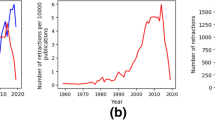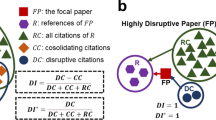Abstract
To describe the impact of the retracted publications on the scientific community more comprehensively, this paper introduces the impact of retracted publications on technology. It establishes a multi-dimensional observation framework for retracted publications from four dimensions, including scientific impact, technological impact, funding impact and Altmetric impact, and proposes the use of a novel multidimensional bubble diagram to illustrate the multidimensional data. This study also proposes a two-dimensional classification of retraction reasons to help sort retracted papers, the results of which show the correlated features of those papers. This paper takes all the retracted publications from two top biomedical journals as a sample, uses the observation framework to analyze them and describes the impact of these papers from multiple dimensions. The results show that compared with one-dimensional analysis, this observation framework reveals the impact characteristics of retracted publications more comprehensively.




Similar content being viewed by others
Notes
For example, the “Duplication of Articles” retraction reason may be due to errors in journal management, or the author may have published the paper more than once.
It should be noted that some citations refer to the cited work as retracted or mention the reason for the retraction. These citations do not increase the retracted paper's impact but act as warning signs.
This platform recommends the best scientific articles from biological and medical fields by global leading experts, rating these articles as 'Good', 'Very Good' or 'Exceptional', which are equivalent to scores of 1, 2 or 3 stars, respectively.
Lens.org is a data platform based on global patent citations of scientific papers jointly developed by Cambia and Queensland University of Technology in Australia. In collaboration with Crossref and the National Medical Library of the United States, Lens.org maps the PMID number and DOI number of patents of the United States Patent and Trademark Office, the World Intellectual Property Organization, the European Patent Office and the Chinese National Intellectual Property Administration and their cited scientific papers. The data platform has been used by Nature Index to evaluate the impact of basic research on technological innovation.
Altmetric.com is part of the Digital Science portfolio of companies. It aims to track and analyze the online activity around scholarly research outputs. Altmetric’s indicators are metrics and qualitative data that are complementary to traditional, citation-based metrics.
According to Lens.org, as of June 27th, 2020, 4,207,235 out of 216,217,040 articles were cited by patents, for a rate of 1.95%.
Dimension is a database that offers the most comprehensive collection of linked data in a single platform; from grants, publications, datasets and clinical trials to patents and policy documents. For more information of Dimension API, see https://www.dimensions.ai/resources/api-documentation/.
References
Azoulay, P., Bonatti, A., & Krieger, J. L. (2017). The career effects of scandal: Evidence from scientific retractions. Research Policy, 46(9), 1552–1569. https://doi.org/10.1016/j.respol.2017.07.003.
Azoulay, P., Furman, J. L., Krieger, J. L., & Murray, F. E. (2012). Retractions. National Bureau of Economic Research Working Paper Series, No. 18499. https://doi.org/10.3386/w18499
Bar-Ilan, J., & Halevi, G. (2017). Post retraction citations in context: A case study. Scientometrics, 113(1), 547–565. https://doi.org/10.1007/s11192-017-2242-0.
Bar-Ilan, J., & Halevi, G. (2018). Temporal characteristics of retracted articles. Scientometrics, 116(3), 1771–1783. https://doi.org/10.1007/s11192-018-2802-y.
Chen, C., Hu, Z., Milbank, J., & Schultz, T. (2013). A visual analytic study of retracted articles in scientific literature. Journal of the American Society for Information Science and Technology, 64(2), 234–253. https://doi.org/10.1002/asi.22755.
Fan, S., & Zhang, Z. (2014). The distribution of retracted articles in scientific literature database. Journal of the China Society for Scientific and Technical Information, 33(04), 375–387.
Fang, F. C., Steen, R. G., & Casadevall, A. (2012). Misconduct accounts for the majority of retracted scientific publications. Proceedings of the National Academy of Sciences of the United States of America, 109(42), 17028–17033. https://doi.org/10.1073/pnas.1212247109.
Furman, J. L., Jensen, K., & Murray, F. (2012). Governing knowledge in the scientific community: Exploring the role of retractions in biomedicine. Research Policy, 41(2), 276–290. https://doi.org/10.1016/j.respol.2011.11.001.
Horbach, S. P. J. M., & Halffman, W. (2019). The ability of different peer review procedures to flag problematic publications. Scientometrics, 118(1), 339–373. https://doi.org/10.1007/s11192-018-2969-2.
Jin, G. Z., Jones, B., Lu, S. F., & Uzzi, B. (2013). The Reverse matthew effect: Catastrophe and Consequence in Scientific Teams. Social Science Electronic Publishing.
Luwel, M., van Eck, N. J., & van Leeuwen, T. N. (2018). The Schön case: Analyzing in-text citations to papers before and after retraction. Paper presented at the 23rd International Conference on Science and Technology Indicators(STI 2018), Leiden, The Netherlands.
Mongeon, P., & Larivière, V. (2016). Costly collaborations: The impact of scientific fraud on co-authors' careers. Journal of the Association for Information Science and Technology, 67(3), 535–542. https://doi.org/10.1002/asi.23421.
Moylan, E. C., & Kowalczuk, M. K. (2016). Why articles are retracted: a retrospective cross-sectional study of retraction notices at BioMed Central. British Medical Journal Open, 6(11), 7. https://doi.org/10.1136/bmjopen-2016-012047.
Shuai, X., Rollins, J., Moulinier, I., Custis, T., Edmunds, M., & Schilder, F. (2017). A multidimensional investigation of the effects of publication retraction on scholarly impact. Journal of the Association for Information Science and Technology, 68(9), 2225–2236. https://doi.org/10.1002/asi.23826.
Stern, A. M., Casadevall, A., Steen, R. G., & Fang, F. C. (2014). Financial costs and personal consequences of research misconduct resulting in retracted publications. Elife, 3, e02956. https://doi.org/10.7554/eLife.02956.
Wright, N. D. (1991). A citation context analysis of retracted scientific articles. (Ph. D.). University of Maryland College Park, ProQuest Dissertations and Theses database.
Zhang, C., Ding, K., & Liu, Z. (2018). Research review on infometric analysis of retracted publications. Documentation Information and Knowledge, 04, 53–66.
Acknowledgments
We thank Zhesi Shen, Manman Zhu and other members of the Center of Scientometrics from the National Science Library, Chinese Academy of Sciences for their important suggestions and Jin Liu from the Institute of Information Engineering, Chinese Academy of Sciences for his meaningful support. This work is supported by Chinese Academy of Sciences (Kefa Regulation Letter [2018] No. 12), and the NSFC (71473236).
Author information
Authors and Affiliations
Contributions
LF, collected the data, implemented the analysis, and wrote the paper. JY proposed the idea and revised the paper. LY proposed the use and design of the bubble diagram and revised the paper.
Corresponding author
Ethics declarations
Conflict of interest
The authors declare that they have no conflicts of interest.
Electronic supplementary material
Below is the link to the electronic supplementary material.
Rights and permissions
About this article
Cite this article
Feng, L., Yuan, J. & Yang, L. An observation framework for retracted publications in multiple dimensions. Scientometrics 125, 1445–1457 (2020). https://doi.org/10.1007/s11192-020-03702-3
Received:
Published:
Issue Date:
DOI: https://doi.org/10.1007/s11192-020-03702-3




